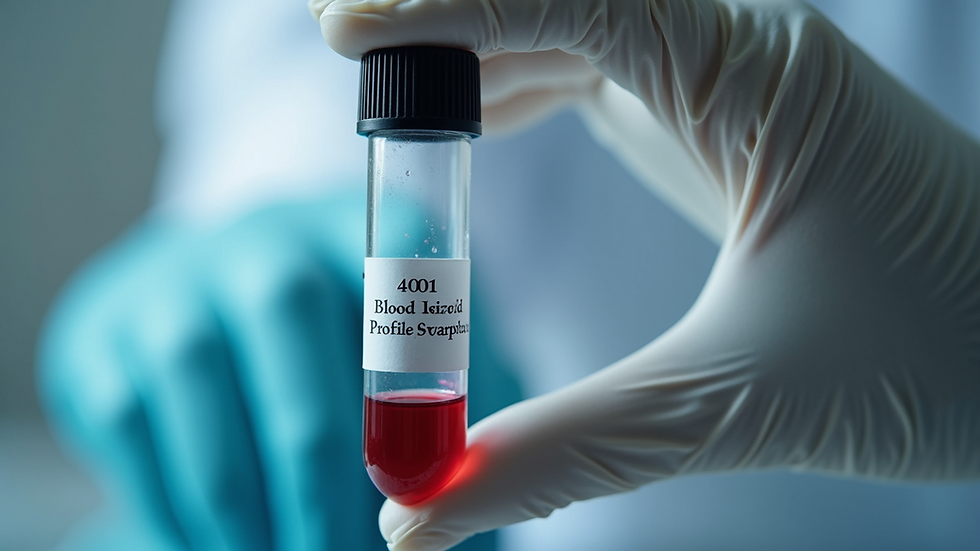How to Understand Your Lipid Profile Test and Its Importance for Your Health
- askhihealth
- Jul 1
- 4 min read
Understanding your health starts with knowledge, especially regarding your heart. One of the key tests to assess your cardiovascular health is the Lipid Profile. This important blood test measures different types of fat molecules, known as lipids, in the blood. It primarily evaluates cholesterol levels and triglycerides, providing insights into overall heart health. This guide will help you understand the Lipid Profile test, why it is performed, and what the results mean for your wellbeing.

What is a Lipid Profile?
A Lipid Profile is a simple blood test that identifies various lipid levels in your bloodstream. It measures:
Total cholesterol: This is the total amount of cholesterol in your blood. A total level under 200 mg/dL is considered healthy.
High-Density Lipoprotein (HDL): Often called "good" cholesterol, HDL helps remove other types of cholesterol from your blood. Levels above 60 mg/dL are considered protective against heart disease.
Low-Density Lipoprotein (LDL): Known as "bad" cholesterol, high levels of LDL can lead to plaque buildup in your arteries. An ideal level is under 100 mg/dL.
Triglycerides: These are the fats in your blood that serve as energy sources. Normal levels are under 150 mg/dL; levels above 200 mg/dL can significantly increase heart disease risk.
A blood sample is drawn from a vein in your arm, and results are typically available within a few days.
Why is the Lipid Profile Test Done?
A Lipid Profile is essential for several reasons:
Routine Screening for Heart Diseases: It is recommended for people at risk of heart disease due to factors like age or family history. For instance, nearly 50% of men and 32% of women will have a heart attack in their lifetime.
Smoking: Smokers face a higher cardiovascular risk, making this test crucial for monitoring heart health.
Diabetes Management: People with diabetes should have their lipid levels checked regularly to avoid complications. More than 70% of adults with diabetes also have high cholesterol.
High Blood Pressure and Obesity: Both significantly raise heart disease risk. Monitoring lipid levels can lead to effective management strategies.
Unhealthy Food Habits: If you consume foods high in fats and sugars, a lipid profile can alert you to potential health risks.
Age Considerations: Individuals over 45 are generally advised to have this test to proactively monitor heart health.
These factors highlight why understanding your lipid levels is so vital for your heart health.
Preparing for Your Lipid Profile Test
Preparing for your Lipid Profile is straightforward but essential to ensure accurate results. Here’s what you should do:
Fasting Requirements: Most doctors recommend fasting for 8-12 hours before the test. Water is okay, but avoid alcohol and certain medications unless instructed otherwise.
Consult Your Healthcare Provider: Discuss any medications or supplements you take with your healthcare professional, as they could interfere with your results.
Proper preparation ensures that your lipid profile accurately reflects your health status.
What Do the Results Mean?
Once you receive your test results, understanding them is vital. Here’s a brief overview of what each lipid level indicates:
Total Cholesterol: Less than 200 mg/dL is healthy; levels 240 mg/dL and higher are considered high risk for heart disease.
HDL: Higher is better. Levels below 40 mg/dL can indicate a risk factor for cardiovascular disease.
LDL: Ideally under 100 mg/dL; levels of 160 mg/dL and higher signify increased risk.
Triglycerides: Normal levels are below 150 mg/dL. Levels between 150 mg/dL and 199 mg/dL are borderline high, while 200 mg/dL and above are concerning.
Your doctor will review these results with you during a follow-up appointment to help create a tailored health plan.
Monitoring and Managing Your Lipid Levels
Regularly monitoring your lipid levels is crucial in preventing heart disease. If your results show elevated levels, consider these management strategies:
Dietary Changes: Adopt a heart-healthy diet rich in vegetables, fruits, whole grains, and lean proteins while reducing saturated fats and sugars. For example, incorporating oats can lower LDL levels by about 5-10%.
Physical Activity: Engage in regular exercise, which can help raise HDL levels and lower LDL and triglycerides. Aim for 150 minutes of moderate exercise weekly.
Weight Management: Keeping a healthy weight can greatly decrease your risk of heart-related conditions. Even a 5-10% weight loss can improve lipid levels.
Medications: In some cases, healthcare providers may prescribe statins or other medications to help manage lipid levels effectively.
The Importance of Regular Testing
Regular lipid profile testing is essential, particularly for those at increased risk for heart disease. Monitoring your lipid levels helps you make informed lifestyle choices and seek medical intervention when needed.
Doctors typically recommend getting your lipid levels checked at least once every 4-6 years if you are in a low-risk category. However, if you are at higher risk, more frequent testing may be necessary to safeguard your heart health.
Summary of Key Insights
Understanding your lipid profile is a critical part of your health journey. By keeping informed about your lipid levels and their impact on heart health, you can take action to manage your cardiovascular health. Beyond routine screenings, being mindful of your diet and lifestyle can help maintain balanced lipid levels and prevent complications.
Highlighting the significance of this test empowers patients to make healthier choices and encourages regular check-ups for a heart-healthy future. Knowledge is key in managing heart health, and the Lipid Profile test is a vital tool in that process.




Comments